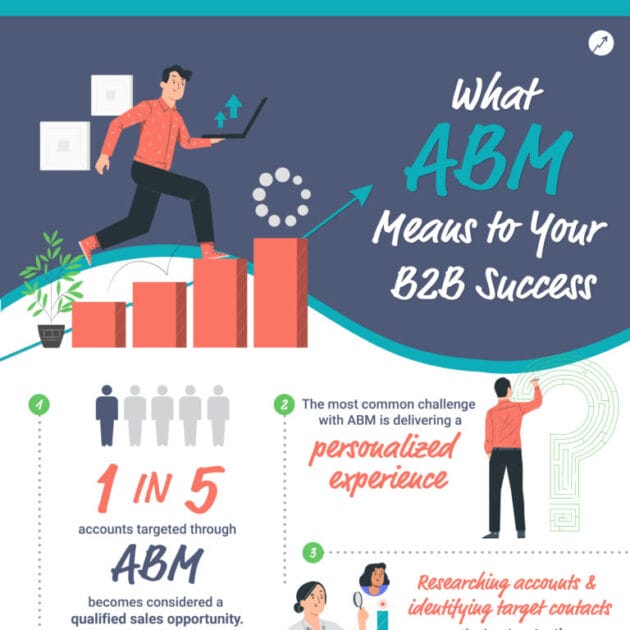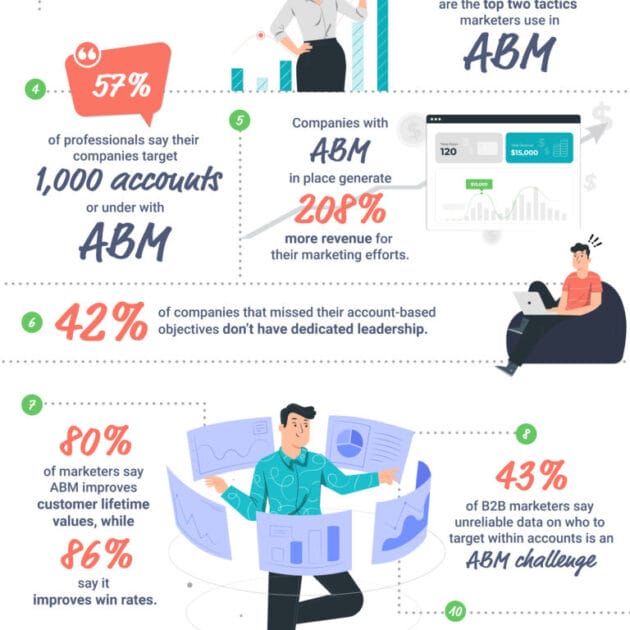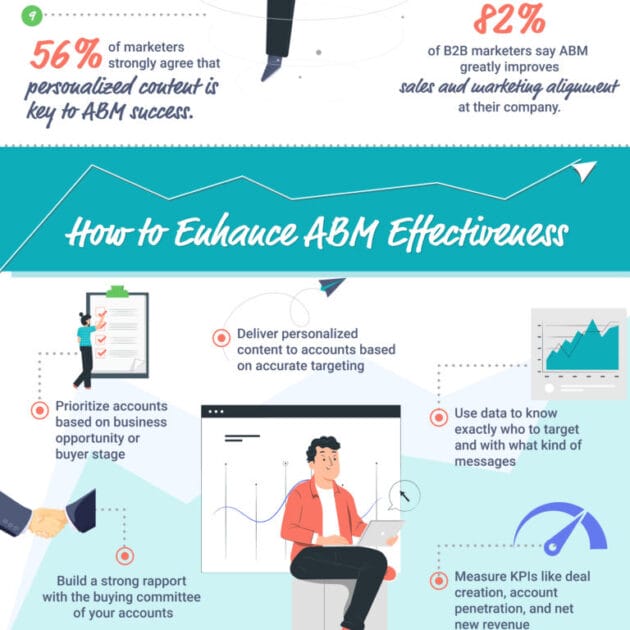Account-based marketing (ABM) is a hyper-targeted, hyper-personalized B2B marketing strategy. Businesses using ABM concentrate their marketing and sales resources on engaging and creating tailored buying experiences for a set of best-fit, highest-opportunity accounts. According to statistics, 86% of marketers say ABM improves win rates and 80% say it improves customer lifetime values.
Sales and marketing alignment or “smarketing” is one of the keys to the success of ABM. The sales and marketing departments play the critical role of mutually identifying high-value accounts and creating extremely relevant, customized account-specific messaging in ABM campaigns.
Why should you plan an Account-based Marketing (ABM) strategy?

Sales and marketing alignment is not only a necessity for ABM. It is also a major benefit for organizations implementing ABM. Let’s look at some more benefits of ABM.
- Streamlined sales cycle. Since ABM only focuses on identifying, converting, and delighting specific high-value accounts instead of unqualified and less-valuable ones, the sales process gets accelerated leading to shorter sales cycles.
- Increased efficiency. ABM allows you to focus your resources on a specific set of accounts that are most likely to generate revenue for your business, rather than spreading your resources too thin.
- Better alignment with sales. An ABM strategy helps align marketing and sales efforts by identifying and targeting key accounts that are most likely to convert.
- Business expansion. ABM involves fostering close, long-term relationships with best-fit accounts, delivering consistent customer experiences, and increasing brand trust. This works great to retain valuable customers, amplify customer loyalty, create testimonials and referrals, promote word-of-mouth marketing, and increase advocates.
- Higher ROI. 87% of B2B marketers reported that their ABM initiatives outperform their other marketing investments in terms of ROI. With better response rates, increased opt-ins, and low resource wastage, ABM is capable of delivering a higher ROI. Not to mention, it is more personalized, precise, and targeted.
- Increased personalization. ABM allows you to tailor your messaging and content to specific accounts, making it more likely that they will be engaged by your marketing efforts.
- Greater impact on target accounts. Since the approach is more focused and tailored the impact will be more on the targeted accounts than a broader approach.
It is important to note that implementation of an ABM strategy requires a different set of tools, processes, and mindset than traditional outbound campaigns. It also requires collaboration across departments and a good alignment of your company’s sales and marketing teams to set up the right goals and track progress.
Recommended for you: Rich Media in Email Marketing: How to Ace the Visual Game? (Infographic).
What are Account-based Marketing (ABM) trends?

Account-based marketing (ABM) has become increasingly popular in recent years, and several trends have emerged in the field. Here are a few of the key trends in ABM:
- Increased use of technology. As technology has advanced, so too has the ability to personalize and automate ABM campaigns. There are many software solutions available that can help you to identify, segment, and target specific accounts, and automate the delivery of personalized content and messaging.
- Greater focus on account engagement. Rather than just focusing on lead generation, ABM strategies are increasingly focusing on engaging with target accounts at all stages of the customer journey. This includes developing relationships with decision-makers and influencers within target accounts and providing valuable content and resources to help move them further down the sales funnel.
- More data-driven approach. ABM is becoming increasingly data-driven, with a greater focus on using data to identify and target the best-fit accounts. Data analytics, machine learning, and AI are being used to personalize campaigns and enhance their performance.
- Growth in account-based advertising. With the rise of digital advertising, account-based advertising (ABA) has become a popular way to reach target accounts and influence their buying decisions. ABA is using programmatic advertising to deliver personalized ads to specific individuals within a target account, on different channels.
- More emphasis on employee advocacy. Companies are focusing on making their employees the brand advocates as they are the ones that are closest to the customer and can build stronger relationships. This helps increase the reach and impact of ABM efforts.
- Greater use of account-based sales development. With a focus on engagement, companies are using account-based sales development (ABSD) as a way to proactively reach out to target accounts, qualify opportunities, and engage decision-makers in meaningful conversations.
Overall, the trend of ABM is moving more towards a holistic approach. It incorporates multiple different strategies and tactics to reach target accounts throughout the customer journey.
Best strategies to improve Account-based Marketing (ABM) results

Here are some powerful tactics to boost your next ABM campaign.
1. Use data intelligence to identify ABM-focused accounts
Adopt a data-driven approach to finding high-value accounts and mapping key contacts to those accounts. Intent data and B2B data are a deadly combination that can supercharge your ABM efforts. Bombora’s Company Surge Intent data and SalesIntel’s 95% accurate, human-verified B2B data are excellent examples of this combination.
The combination allows you to identify accounts showing high purchase intent or high interest in you or your competitor. It then helps you quickly find and contact decision-makers and key influencers at those accounts. Furthermore, you are enabled to reach target accounts early in their buyer’s journey and build meaningful relationships with them.
2. Create personalized and targeted engagement
Ensure that you have all the data and have done all the research you need to engage target accounts in a more relevant, customized, and personalized manner. Know what your target accounts are looking for, what their needs, pain points, and expectations are, what channels they are mostly active on, etc.
Keep your ABM content and messaging highly specific and tailored to target accounts. You can also plan personalized, account-specific in-person events or webinars, direct mail campaigns, email marketing campaigns, air cover campaigns, and ad targeting to further enhance your ABM ROI.
3. Build the perfect ABM team
A complete ABM team would include the ABM head, salespeople and BDRs, marketing reps, digital marketing manager, content manager, and integrated campaign manager. If your company size is small or you have a lower budget. Include people who can handle multiple tasks such as those involving both online and offline channels.
Create a strategic playbook where you define the roles and responsibilities of each team member, include ABM campaign cadences, and assign accounts or contacts to specific team members. Ensure sound communication within the team and conduct regular meetings to keep everybody on the same page.
What ABM means to your B2B success? (Infographic)




Infographic source: SalesIntel.
You may also like: Holiday Email Marketing: How to Win Maximum Customers During the Peak Season? (Infographic).
Final words

Besides these strategies, make sure you measure your ABM results and accordingly work on areas that need improvement. Lastly, don’t shy away from using ABM platforms and tools to automate your campaigns and drive better outcomes.
This infographic is provided by Ariana Shannon. Ariana is the Marketing Director at SalesIntel. SalesIntel provides the most accurate and affordable b2b data. You can follow her on LinkedIn.





